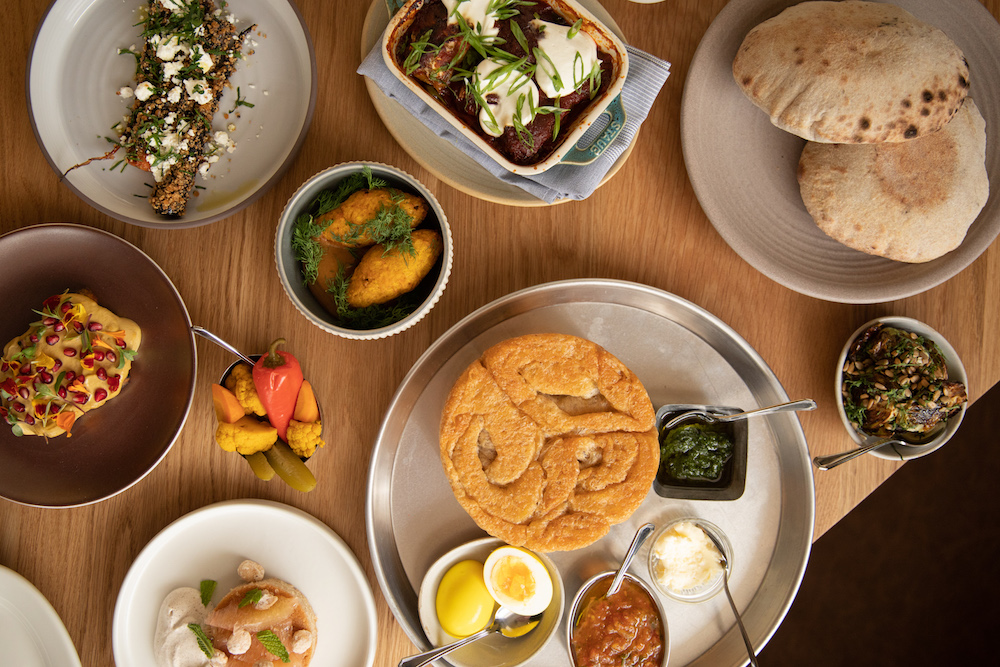Hummus. Pita. Falafel. Shakshuka. Chef Zach Engel’s goal at Galit is to take these fairly common Middle Eastern dishes to the next level. “This opening menu right now is meant to introduce Chicago to the things that they’ve had before but never done this well,” says Engel.
Engel has the pedigree to make such an ambitious goal a reality: He’s already wowed New Orleans audiences as the chef at Shaya, earning a Beard Award as a rising star chef, and he started his culinary career at the legendary Zahav. So it’s possible that Engel knows a thing or two about modern middle eastern food. His move to Chicago was a little bit random; he describes a somewhat itinerate lifestyle where, instead of taking vacations, he and his wife move around every few years and live in a new place. Chicago is just his latest stop (though he admits that he first enjoyed the city during the summer).
Engel came to town on his days off from his previous job and got himself connected with all the necessary restaurant insiders (like contractors, attorneys and investors), as well as his partner, Andres Clavero (formerly of One Off Hospitality). “The entire process has been absolutely insane for a dinner-only, 100 seat restaurant that serves chickpea puree, basically,” Engel says.
The result, however, is a menu that makes me want to get up from my desk and run to the restaurant right now, with plenty of those basics Engel wants to show off, as well as what he describes as “more cheffy” dishes. Everything is small and shareable. “It’s a little truer to the style of how you’d eat in Israel at someone’s house: You get bombarded with a bunch of stuff all at the same time,” he says.
Most of the dishes are cooked over a custom-built 8-foot charcoal hearth, and because of that cooking method, dishes like carrots with hazelnut dukka are rapidly becoming the most popular on the menu. He’s not kidding about his ambition to have the best of the basics.
In addition to his “ethereal” hummus, he raves about his falafel, describing it as “bright, spiced, crispy, herby, and funky” and served with fermented mango. Regarding his shakshuka, made with coal-roasted sweet potatoes: “You might think you’ve had good shakshuka, but this is meant to be the best you’ve ever had. That’s what I’m trying to do.”
One of the most endearing bits of Galit is the way the menu reads. He admits that it’s a little bit cheeky (“I have to make sure I’m not generating an eye roll”) but it’s also a little bit adorable, with a tehina described as having “way too much olive oil”, shakshuka with “so many fresh herbs” and a Sonoma Zinfandel labeled “if your post-workout berry smoothie was wine.” He’s particularly dedicated to making the wine list approachable and fun. “95 percent of people who sit down at restaurants are afraid to order wine,” says Engel, especially when a wine list is dominated by specially sourced Middle Eastern wine varieties people probably aren’t familiar with.
Galit isn’t all basics; a version of an Iraqi dish, kubbe halab, is made with a crust of saffron rice, stuffed with lamb and harissa, and then fried and topped with a sauce made from almonds and golden raisins. Engel is particularly proud of his butternut bazhe, a walnut based sauce that’s usually made with cream, butter and more cream. This one is vegan, made thick and rich with butternut squash and with a pomegranate zip.
Most of the menu at Galit is vegetarian, and a lot is vegan friendly. However, Galit’s not all about plants: “I have foie on the menu because I think it’s fun to sit around and spread foie gras on challah, drink some wine, and have a good time.”




